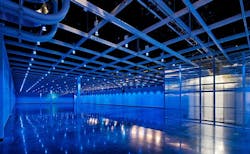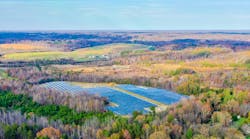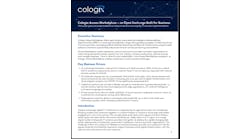What if you could take energy that’s currently going to waste, and use it to generate green electricity to power data centers? That’s the goal of a new partnership between Aligned Data Centers and Swedish energy company Climeon, which aims to harness low-grade waste heat and convert it into green energy.
Climeon’s heat recovery technique is used to convert waste heat into energy on cruise ships, including Richard Branson’s new Virgin Voyages.
Aligned Energy CEO Jacob Carnemark says the same technology can be used to capture heat from water treatment plants, paper mills and electric utilities and use it to offset the growing power use of large data centers.
This approach could create a steady source of clean energy, addressing a key challenge with renewable energy sources like solar and wind power, which are both intermittent.
The potential breakthrough is Climeon’s ability to create energy from low-grade waste heat, which is typically between 50 and 70 degrees C (between 120 and 160 F) and is difficult to convert into energy with decent efficiency. That’s different from high-grade heat (200 C and above), which can be used in combined heat and power (CHP) systems.
Addressing a Tough Problem
Aligned Data Centers hopes to bring cloud-style pricing and hyperscale-level efficiency into the multi-tenant data center sector. Its approach is focused on the supply chain and solving the data center capacity management challenge. Its focus is on eliminating waste and inefficiency in data center design and operations, especially in cooling.
Aligned Energy launched its first data center in Plano, Texas earlier this year and is now preparing to open its second facility in the Phoenix market. The Phoenix project will be a 550,000 square foot, 62 megawatt campus, and is scheduled to come online in early 2017
The company’s newest initiative on energy initiative reflects the growing emphasis on sustainability for data center customers.
“One of the vexing problems is that all these cloud computing providers are looking for green energy,” said Carnemark. “In most cases if you want to use clean electricity, converting solar and wind power are the typical methods. However, the sun doesn’t always shine and the wind doesn’t always blow.
“By cultivating this largely untapped resource in waste heat and converting it to 100 percent stable green baseload power, and by being able to use low temperature geothermal sources, we can support the data center industry’s rising demand for green energy in ways not previously possible through this new, highly sustainable and reliable approach.”
Carnemark sees the potential to use the Climeon technology to support Aligned’s current data centers, as well as providing clean energy for build-to-suit projects for hyperscale cloud providers. Either approach will take some time to implement, but Carnemark says Aligned is working with local utilities to make this vision a reality.
How Climeon Works
Climeon technology is delivered in a module that requires just three connections: A hot water source, a cold water source and a power connection. The 150 kW generation unit has a footprint of just four square meters.
The module can run 24×7 with just two days planned maintenance per year. Installation requires only three connections, a hot source, a cold source and a power connection. On the hot side, the unit operates at temperatures between 70 and 120 degrees C, while the cold side is typically between 0 and 30 °C and can be sourced from cooling tower or a natural source (river, lake or ocean).
An illustration of how Climeon uses waste heat to generate energy.
The incoming waste heat converts a working media from liquid to gas. The gas occupies more space than the liquid, creating pressurized gas passes through a turbine. which generates clean electricity. The gas is cooled after it passes through the turbine, and converts back to liquid and recirculates in a closed loop.
The Climeon system can scale in increments of 150 kW by adding more modules. The system is being used by Swedish steel producer SSAB, and also by cruise ships, which use Climeon to harness waste heat from the ship’s huge engines. After an initial trial on Viking cruise ships, Climeone has been chosen by Italian shipbuilder Fincantieri for its new cruise vessels, including a new line of ships for Richard Branson’s rebranded Virgin Voyages line.
“To meet the challenges of climate change, the world needs new clean energy sources,” said Thomas Öström, CEO of Climeon. “The Climeon system is just that, producing 100% clean energy and a new baseload for electricity.”
Carnemark identified Climeon as a potential partner early in the development of Aligned Data Centers’ integrated appraoch to the suply chain.
“We’ve been working with this company in research and development for about four years,” said Carnemark. “We’ve proven its viability and we’re ready to start doing this tomorrow.”
Working With Utilities, Factories
Aligned’s initial deployment plan involves working with local utilities to harvest waste heat, either from the utility itself or from other large industrial power customers. Most utilities already have programs to capture high-grade waste heat and reuse it, typically in a CHP plant. However, these utilities often have no similar program for low-grade waste heat, creating an opportunity for Aligend and Climeon.
Carnemark said Aligned hopes to partner with local utilities to identify potential sources of low-grade waste heat, both in the utility’s generation system and among customers.
“The other area to look at is water treatment plants and pulp and paper mills,” said Carnemark, who said the cost of the energy produced will be on par with wind energy, and less expensive than solar.
An air containment system inside a data hall at the Aligned Data Center facility in Plano, Texas near Dallas. (Photo: Aligned)
“We’re trying to bring new technologies onto the market to create new ecosystems.” said Carnemark. “We’re talking with utilities in the markets where we operate. We’re trying to offset 100 percent of our load of our data centers with this product. This is not something that would require subsidies, just good partnerships.”
Aligned also sees possibilities in working with large cloud providers on data center campuses that could use geothermal energy as a source for hot water. Geothermal energy systems circulate water through deep wells, using the earth’s energy at depth to to warm water. Using Climeon could allow a geothermal system to work with lower water temperatures and shallower wells, creating more favorable economics.
It could also expand the range of geographies in which geothermal can be an effective power source, highlighting the importance of data center site selection.
“I believe the most tactical way to work with large cloud providers is to bring them to the table and work together on site selection,” said Carnemark. “I think solving the climate problem requires closer partnerships between cloud players and utilities.”
Data centers are known for their ability to produce low-grade waste heat from the hot aisle of the data hall. The problem is that the air from server exhaust isn’t hot enough for energy use, even with the Climeon system.
“This is not for recovering server exhaust heat,” said Carnemark. “It’s not hot enough. Some day in the future there may be an opportunity.”






